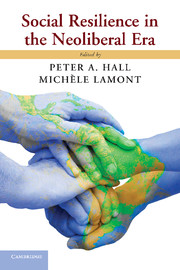Introduction
Social Resilience in the Neoliberal Era
Published online by Cambridge University Press: 05 May 2013
Summary
This book is an effort to assess developments in a neoliberal era spanning the past three decades of global history. Although social science examines many phenomena, it looks only rarely at what Pierson (2003) calls “big, slow-moving processes.” We are often not aware of the sands shifting beneath our feet as events change the character of the times in diffuse ways. Beginning in the 1980s, the growing influence of market-oriented ideas constituted just such a process, global in scope, pervasive in effects. We want to know what consequences neoliberal ideas and policies had for social, economic, and political life. But even more central to this inquiry is a desire to understand the process whereby neoliberal ideas worked their way into the policies of governments, the operation of organizations, and the lives of ordinary people. In that respect, this volume is an investigation into the dynamics of social change.
Compared with many studies, this one involves a shift in optics. Neoliberalism is often analyzed as a set of policy reforms reflecting a class politics that ranges capital against labor (Duménil and Lévy 2004; Harvey 2005). Although that approach has some validity, such perspectives tend to treat a multidimensional set of developments in largely economic terms and sometimes overemphasize the negative effects of neoliberalism. Perspectives that treat neoliberalism as a cultural phenomenon offer a useful corrective but often overstate the domination of neoliberal ideas over social life. In this volume, we try to integrate economic, political, and cultural analyses of neoliberalism, and instead of seeing it as a development with homogenous effects across space and time, we view it as a more open-ended stimulus that provoked a diversity of responses.
- Type
- Chapter
- Information
- Social Resilience in the Neoliberal Era , pp. 1 - 32Publisher: Cambridge University PressPrint publication year: 2013
References
- 32
- Cited by



